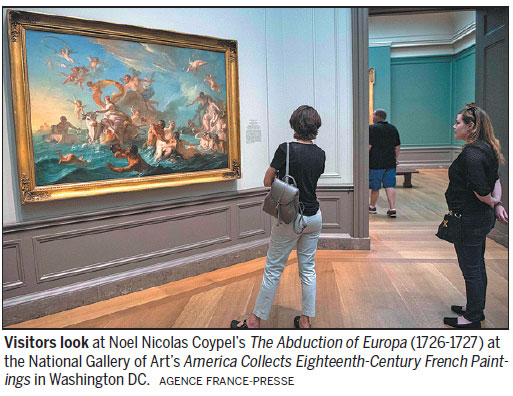WASHINGTON - When Napoleon's elder brother Joseph Bonaparte was forced into exile, he brought to the United States a collection of lavish rococo and neoclassical paintings that earned enduring fascination.
Among the works Bonaparte left behind when he returned to France in 1839 was Noel Nicolas Coypel's The Abduction of Europa (1726-1727), a period indulgence, complete with fleshy nudes, cherubs and a white bull basking in golden sunlight.
Bonaparte would show off this monumental work to visitors at his sprawling Point Breeze estate in New Jersey at a time when so much nudity still had the power to seriously offend.
In a perhaps oddly humoristic touch, the bull - the mythological god Jupiter, who transformed himself into the earthly creature to abduct the nymph Europa - is presented tongue out and eyes half-closed in delight.

Thomas Jefferson, too, helped fuel interest with his earnest appreciation of works he saw at the Paris Salon, especially what he called "superb" paintings by Jacques Louis David.
These and other stories of the collectors, dealers and art lovers behind the huge trove of 18th century French paintings spread across the US are the focus of an exhibition that opened Sunday and runs through August 20 at the National Gallery of Art in Washington.
This first-ever look at the US' love affair with 18th century French painting strays from the beaten path by showing a great variety of works from this period in an unusual grouping that prominently features women artists and even one of the first known mixed-race painters in the Western canon, Guillaume Lethiere.
The show also reflects the elevated status US institutions have given to French women painters of the era, one that is notably diminished in their native country.
Royal ties revered
In entering a room dedicated to more playful and fanciful expression, painted in the pastel blue once associated with theater, Marie Antoinette's court painter Joseph Ducreux admonishes the viewer to keep quiet, his index finger pressed firmly against his lips in his little known self-portrait Le Discret (circa 1791).
Or could he have committed some grave transgression and is anxiously demanding you keep his secret? Ducreux leaves you guessing.
"We tend to have a perception of these works of art as relatively heavy or serious or purely decorative," says assistant curator Yuriko Jackall.
"So being able to present them as sometimes ironic or mocking, hopefully shows a new aspect."
The period during which many of the works shown here came into American hands was one in which US collectors were especially keen on acquiring objects with royal connections - ties that collectors played up, be they real or imagined.
At a sale in 1905, the Self-Portrait with a Harp (1791) by Ducreux's daughter Rose Adelaide Ducreux was incorrectly presented as a work by Elisabeth Vigee Lebrun, then revered for her role as Marie Antoinette's portrait painter.
It was also a time when entire rooms were shipped across the Atlantic - from a "Marie Antoinette Boudoir" transplanted to the Deacon House in Boston with its ceiling of Fragonard cherubs to Alva Vanderbilt's Louis XV-style white and gold New York salon featuring Francois Boucher tapestries.
In one of the more fascinating discoveries made during the five years of preparations for the National Gallery's show, Jackall and a team of researchers found that one of the museum's most beloved paintings, Fragonard's Young Girl Reading (circa 1770), was in fact painted over a long-lost composition.
Near-infrared and X-ray technology helped reveal a painting of a woman with a feathered headdress gazing directly at the viewer. It had previously belonged to a series of 18 known as Fragonard's "fantasy figures."
Agence France-Presse
